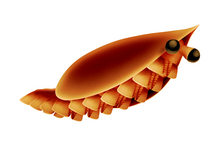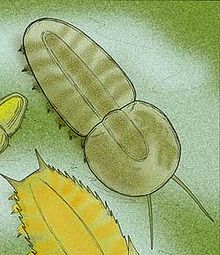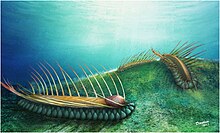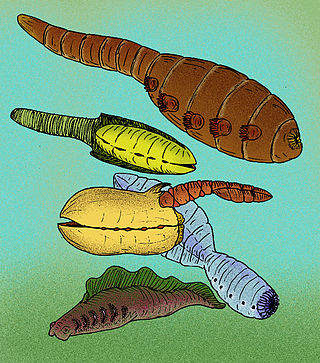
Vetulicolia is a phylum of bilaterian animals encompassing several extinct species belonging to the Cambrian period. The phylum was created by Degan Shu and his research team in 2001, and named after Vetulicola cuneata, the first species of the phylum described in 1987.
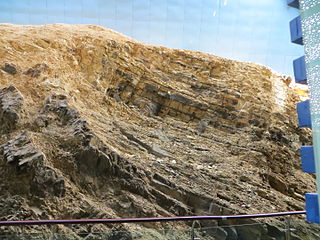
The Maotianshan Shales (帽天山页岩) are a series of Early Cambrian sedimentary deposits in the Chiungchussu Formation, famous for their Konservat Lagerstätten, deposits known for the exceptional preservation of fossilized organisms or traces. The Maotianshan Shales form one of some forty Cambrian fossil locations worldwide exhibiting exquisite preservation of rarely preserved, non-mineralized soft tissue, comparable to the fossils of the Burgess Shale of British Columbia, Canada. They take their name from Maotianshan Hill in Chengjiang County, Yunnan Province, China.

Sidneyia is an extinct arthropod known from fossils found from the Early to the Mid Cambrian of China and the Mid Cambrian Burgess Shale of British Columbia, Canada.

Anomalocaris is an extinct genus of radiodont, an order of early-diverging stem-group arthropods.

Vetulicola is an extinct genus of marine animal discovered from the Cambrian of China. It is the eponymous member of the enigmatic phylum Vetulicolia, which is of uncertain affinities but may belong to the deuterostomes. The name was derived from Vetulicola cuneata, the first species described by Hou Xian-guang in 1987 from the Lower Cambrian Chiungchussu Formation in Chengjiang, China.

Cathaymyrus is a genus of Early Cambrian chordate known from the Chengjiang biota in Yunnan Province, China. Both species have a long segmented body with no distinctive head. The segments resemble the v-shaped muscle blocks found in cephalochordates such as Amphioxus. A long linear impression runs along the "back" of the body looking something like a chordate notochord.
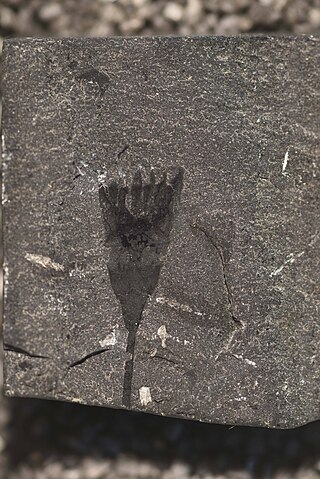
Dinomischusis an extinct genus of stalked filter-feeding animals within the Cambrian period, with specimens known from the Burgess Shale and the Maotianshan Shales. While long of uncertain affintiies, recent studies have suggested it to be a stem-group ctenophore.
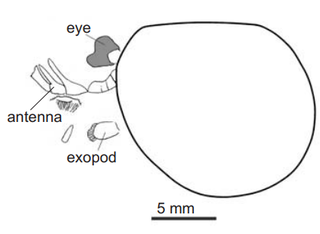
Forfexicaris valida is a species of Lower Cambrian arthropod, the only species in the family Forfexicarididae. It is known from only two specimens from the Maotianshan shale Lagerstätte.

Facivermis is a genus of sessile lobopodian from the Lower Cambrian Maotianshan shales of China

Branchiocaris is an extinct genus of Cambrian bivalved arthropod. The type and best known species, Branchiocaris pretiosa, was described from the Burgess Shale of British Columbia, Canada, in 1929, originally placed in Protocaris, and was placed into its own distinct genus by Briggs in 1976. Several other possible species have been described from Cambrian deposits in China, and it is also possibly known from Cambrian deposits in Utah. Branchiocaris pretiosa is around 80–90 millimetres (3.1–3.5 in) in length, with a highly segmented trunk, consisting of at least 44 ring-like segments, terminating in a forked tail telson. At the front of the animal is a pair of short segmented tapered antennules with at least 20 segments, as well as a pair of claw appendages. It was likely an active swimmer, and used the claw appendages to bring food to the mouth.

Panlongia was a small-sized marine arthropod, with an oval-shaped non-calcified exoskeleton. Both the head shield and the tail shield are semi-circular. In between the cephalon and pygidium are four thoracic body segments (somites). The cephalon occupies approximately ⅓ of the body length, the thorax ¼ and pygidium about 45%. Panlongia lived during the late Lower Cambrian (Botomian) in what is today South China. In Panlongia spinosa the edge of the exoskeleton carries several small sawtooth-like spines, that are absent in P. tetranodusa.

Miraluolishania is an extinct lobopodian known from Chengjiang County in China. It is remarkable for the possession of lensed pit-eyes. The only species, Miraluolishania haikouensis, was described from the Maotianshan Shales at Haikou by Jianni Liu and Degan Shu in 2004. In 2009, a team of palaeontologists at the Yunnan University, led by Xiaoya Ma reported the discovery of 42 other specimens from Haikou. With the help of Swiss palaeontologist Jan Bergström, Ma and Hou came to the conclusion that all the specimens were the same species as Luolishania; another lobopod discovered from the Chengjian in 1989. Chengjian is 40 kms from Haikou and the fossil fauna are different. A reassessment by Liu and Shu's team at the Northwest University in 2008 established that Luolishania and Miraluolishania are distinct animals.
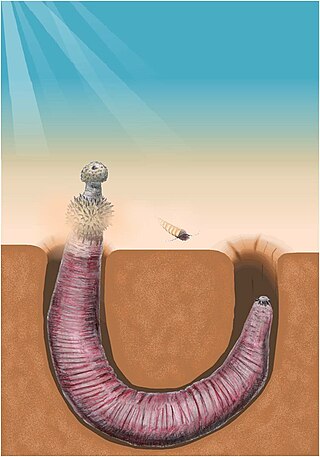
Archaeopriapulida is a group of priapulid worms known from Cambrian lagerstätte. The group is closely related to, and very similar to, the modern Priapulids. It is unclear whether it is mono- or polyphyletic. Despite a remarkable morphological similarity to their modern cousins, they fall outside of the priapulid crown group, which is not unambiguously represented in the fossil record until the Carboniferous. In addition to well-preserved body fossils, remains of several archaeopriapulid taxa are known to have been preserved primarily as organic microfossils, such as isolated scalids and pharyngeal teeth. They are probably closely related or paraphyletic to the palaeoscolecids; the relationship between these basal worms is somewhat unresolved.

The palaeoscolecids are a group of extinct ecdysozoan worms resembling armoured priapulids. They are known from the Lower Cambrian to the late Silurian; they are mainly found as disarticulated sclerites, but are also preserved in many of the Cambrian lagerstätten. They take their name from the typifying genus Palaeoscolex. Other genera include Cricocosmia from the Lower Cambrian Chengjiang biota. Their taxonomic affinities within Ecdysozoa have been the subject of debate.

Vetulicola rectangulata is a species of extinct animal from the Early Cambrian of the Chengjiang biota of China. Regarded as a deuterostome, it has characteristic rectangular anterior body on which the posterior tail region is attached. It was described by Luo Huilin and Hu Shi-xue in 1999.
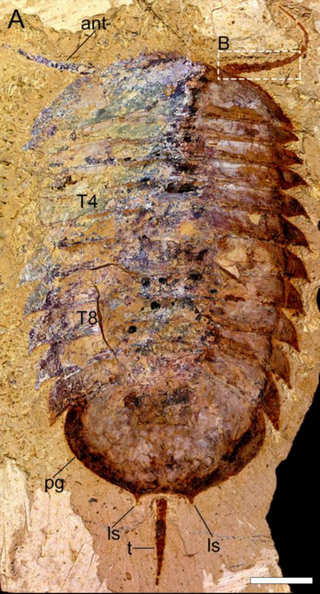
Retifacies abnormalis is an extinct arthropod that lived in the lower Cambrian. Its fossil remains have been found in the Maotianshan Shales of Yunnan, China. It is a member of the Artiopoda, and closely related to Pygmaclypeatus.
Luolishania is an extinct genus of lobopodian panarthropod and known from the Lower Cambrian Chiungchussu Formation of the Chengjiang County, Yunnan Province, China. A monotypic genus, it contains one species Luolishania longicruris. It was discovered and described by Hou Xian-Guang and Chen Jun-Yuan in 1989. It is one of the superarmoured Cambrian lobopodians suspected to be either an intermediate form in the origin of velvet worms (Onychophora) or basal to at least Tardigrada and Arthropoda. It is the basis of the family name Luolishaniidae, which also include other related lobopods such as Acinocricus, Collinsium, Facivermis, and Ovatiovermis. Along with Microdictyon, it is the first lobopodian fossil discovered from China.

Hallucigeniidae is a family of extinct worms belonging to the group Lobopodia that originated during the Cambrian explosion. It is based on the species Hallucigenia sparsa, the fossil of which was discovered by Charles Doolittle Walcott in 1911 from the Burgess Shale of British Columbia. The name Hallucigenia was created by Simon Conway Morris in 1977, from which the family was erected after discoveries of other hallucigeniid worms from other parts of the world. Classification of these lobopods and their relatives are still controversial, and the family consists of at least four genera.

Lenisambulatrix is a genus of extinct worm belonging to the group Lobopodia and known from the Lower Cambrian Maotianshan shale of China. It is represented by a single species L. humboldti. The incomplete fossil was discovered and described by Qiang Ou and Georg Mayer in 2018. Due to its missing parts, its relationship with other lobopodians is not clear. It shares many structural features with another Cambrian lobopodian Diania cactiformis, a fossil of which was found alongside it.

